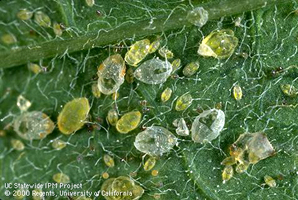|
|
Back to Pest Identification and Diagnosis
| Introduction to Whiteflies | Key to Whiteflies | Silverleaf Whitefly | Sweetpotato Whitefly | |||
| Greenhouse Whitefly | Citrus Whitefly |
INTRODUCTION TO WHITEFLIES
 |
 A. Pupal case (when viewed from the side) appears to be sitting on closely set posts of wax around the margin B. Pupal case with a dark area along the back C. Adult with gray bands across the wings |
|
|
Silverleaf Whitefly Nymphs and Pupae From: University of California |
| INTRODUCTION TO WHITEFLIES | |
|
Whiteflies are very small insects that resemble tiny white moths. Whiteflies usually feed on the lower surface of their host plant leaves. Whiteflies differ from most insects in the way they mate (side by side) and that their eggs absorb water from the host leaf after the eggs are inserted into the lower surface. From the egg hatches a minute crawler stage that moves about the leaf until it inserts its microscopic, threadlike mouthparts to feed by sucking sap from the phloem. Adults and nymphs excrete honeydew, a sticky, viscous liquid in which dark sooty molds grow. Because many species of adult whiteflies are similar in appearance, entomologists use the last nymph stage for specific identification. In 1986, a whitefly very similar to the sweetpotato whitefly suddenly became a noticeable pest of poinsettias and commercial vegetables in Florida and California. This whitefly spread throughout the greenhouse industry in the United States in the next few years and is now the most frequently encountered whitefly pest of poinsettia and gerbera daisy. In 1994, Bellows and Perring described this whitefly as a new species, the silverleaf whitefly. The silverleaf whitefly causes the leaves of melons and stems of poinsettias to blanch noticeably when these whiteflies are abundant. |
| Introduction to Whiteflies | Key to Whiteflies | Silverleaf Whitefly | Sweetpotato Whitefly | |||
| Greenhouse Whitefly | Citrus Whitefly |
Back to Pest Identification and Diagnosis
 |
(C) Regents of the University of
Minnesota. All rights reserved. |
 |
 |